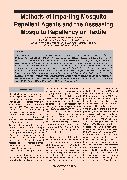Methods of Imparting Mosquito Repellent Agents and the Assessing Mosquito Repellency on Textile Aufa Adeela Anuar* and Nurain Yusof Textile Research Group, Faculty of Applied Sciences, MARA University of Technology, Shah Alam 40450, Selangor, Malaysia *Correspondence: aufaanuar20@gmail.com Abstract This review intends to analyze the distinctive fabric utilized for mosquito repellent studies and forms of treatment mosquito agents on the fabrics. Textile treated with mosquito repellent is a revolutionary innova- tion to protect human from the bites of mosquito borne disease such as Dengue. This peculiarity was produced as needed in feeling of assurance from mosquitoes in the regions which are territories of the mosquitoes and inclined to disease. To impart this feature, the fabrics are given a treat- ment of mosquito repellent agent which capable of being utilized and without ruining their characteristics. The utilization of anti-agents to dress and di?erent fabrics is best contrasted with skin application in light of the fact that it lessens the probability of unfavorably susceptible responses. This paper described the textile materials selection, methods of imparting the repellent into the fabrics, types of repellent as well as the repellency test of treated fabrics. The assessments used in the treated textile are sum- marized and conditions of the assessment of repellency relative to this discussion are presented. Introduction Mosquito bites can give an unpleas- ant feeling and may transmit the vec- tor disease such as dengue or malaria to humankind. Mosquitoes are attract- ed to human blood con- taining protein to develop their eggs, biting human to another human, thereby trans- mitting the vector disease to human. The ge- nus Aedes mosquitoes are responsi- ble to transmit the vector of dengue all over the worlds with billion people suf- fer from the dis- ease and also death cases reported (Division of Vector- Borne Disease 2012). There are only a few vaccines to treat the virus caused by mosquito bites, however, in the case of dengue, researchers are yet to find the vaccines for it (Farag et al. 2011) the best way is for people to avoid mosquito bites. Repellents are practi- cal products and economical means to prevent the transmissions of the mos- quito vector disease (Yang & Ma 2005). Hence, personal protective measure must be taken to protect human from mosquito bites. Applying mosquito re-pellents either on their skin, house, even on their clothing or upholsteries may help in protecting human against mosquito bites. Repellents that applied to skin or clothing produce a vapor lay- er that has an offensive smell or taste and makes a person unattractive for feeding and therefore repels the mos- quito (Brown and Hebert 1997; Fradin and Day 2002) several studies showed that most repellents was developed in the form of lotions, cream, essential oils, spray, or solution where in most cases require direct application to the human skin (Amer and Mehlhorn 2006; Ariffin et al. 2012; Fei and Xin 2007; Fradin and Day 2002; Snodgrass 1992; Yates et al. 2005). Treating the garment fabrics with re- pellent agent is another way to avoid mosquito bites as the big proportion of the human skin is covered by the treated garment thus, avoid- ing it to be exposed to the blood sucking mos- quitoes. Imparting the mosquito repel- lents onto the textile and cloth impreg- nating laundry emulsions application is one of the inno- vatory and practical NCM-OCTOBER 2021 35approach in daily routine to driving away the blood sucking arthro- pods from people (Brown and Hebert 1997; Maheshwari and Ramya 2014). The present inventions of mosquito repel- lents to be imparted into the fabric can be produced using various techniques such as addition during rinse cycle, direct coating, finishing like cloth im- pregnating laudry emulsions and oth- ers (Anitha et al. 2011; Anuar and Yusof 2016; Farag et al. 2011; Fei and Xin 2007; Snodgrass 1992; Sumithra and Vasugi Raja 2012; Troutman 2009; Van Winkle 2002). The textiles with mos- quito repelling features exhibit a char- acter that can drive the mosquito away from the treated textile, or by knock- ing down the mosquitoes when it is in contact with the treated textiles. The applications of the mosquito repellent feature must not damage the original characteristic of the textile materials itself. The value added of repellent properties also for textile material is a novel approaches as it by means can help to reduce the statistics of vector disease cases with- out giving a side effect to the wearer. According to a
